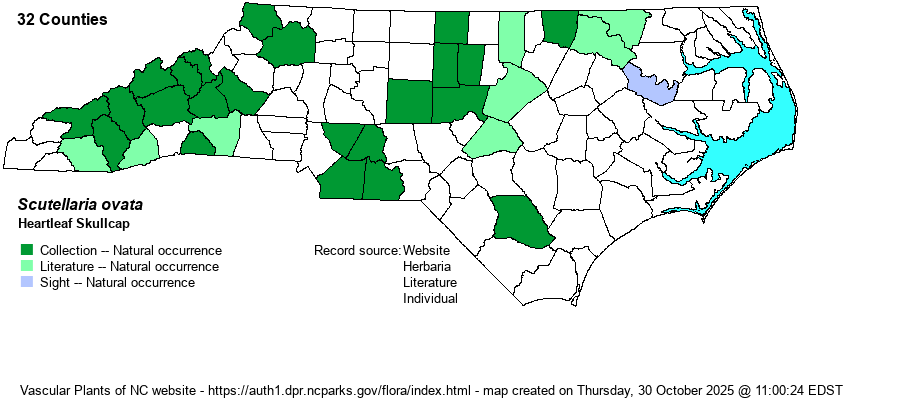| Author | Hill | |
| Distribution | Present over most of the Mountains, scattered over much of the Piedmont, and at a few places in the upper Coastal Plain along brownwater rivers (Roanoke and Cape Fear rivers). Odd gap in the range in the west-central Piedmont.
This is a mainly Midwestern species, ranging eastward to MD and GA and westward to MN and central TX. It is scarce in the Coastal Plain. | |
| Abundance | Uncommon in the Mountains, rare to locally uncommon in the central and eastern Piedmont, and rare along the upper parts of the Roanoke and Cape Fear rivers. Seemingly very rare in the west-central Piedmont, but ought to be present in most counties in the province. The NCNHP tracks one variety as Significantly Rare, and several others as Watch List. Their overall State Rank of S2 is clearly too conservative and may be biased by the many S1 and S2 ranks of the various taxa. It is certainly S3, with the website map containing records for 31 counties so far. | |
| Habitat | This is a species of high pH shaded soil, usually where rich. It grows in Basic Mesic Forests, Rich Cove Forests, Natural Levee Forests, and other similar rich forested places. | |
| Phenology | Blooms from May to July, and fruits from June to September. | |
| Identification | This is a medium-sized Scutellaria, with a rather stout stem, growing to about 1.5-2 feet tall, with no or only a few upper branches. It is quite pubescent on the stems and leaves. The relatively few leaves are paired, usually on petioles up to 1-inch long, and with noticeably rounded blades and a cordate leaf base. Each blade is ovate to nearly rounded, about 3-4 inches long and nearly as wide, with crenate margins. There are only 1-3 racemes in the upper axils and stem tip, but each is several inches long and contains many flowers. Each flower is lavender-blue, hooded, and about 3/4-inch long. As with many others in the genus, individuals of this species can grow in colonies, and one in bloom is quite showy, especially with the relatively wide leaves. Note that, as there are several subspecies and varieties found in NC, there will be considerable variation in plants from one part of the state to another. This is a species that may take time to find, unless you specifically target sites over mafic rocks or other very rich shaded soil. | |
| Taxonomic Comments | Hardly any species in NC has more confusing taxa than this one, as not only are there a few subspecies but Weakley (2018) lists varieties within subspecies! The ones that he considers to occur in NC are ssp. bracteata, ssp. ovata var. ovata, and ssp. ovata var. 1 (undescribed).
| |
| Other Common Name(s) | None | |
| State Rank | S2 [S3] | |
| Global Rank | G5 | |
| State Status | | |
| US Status | | |
| USACE-agcp | UPL link |
| USACE-emp | FACU link |

